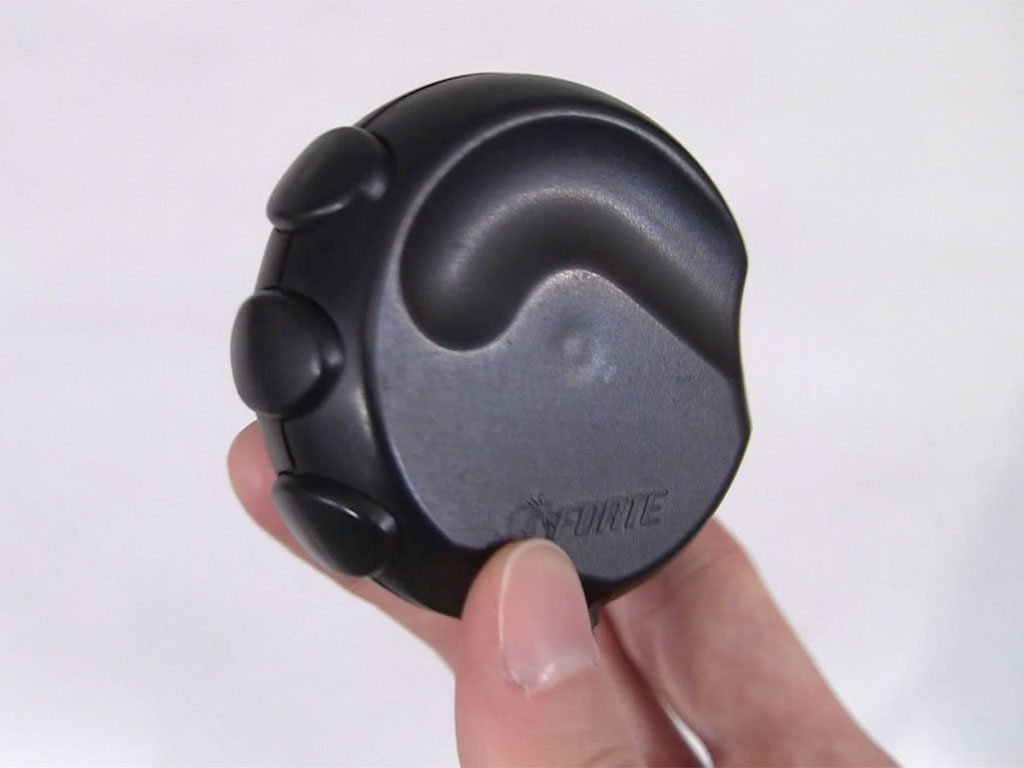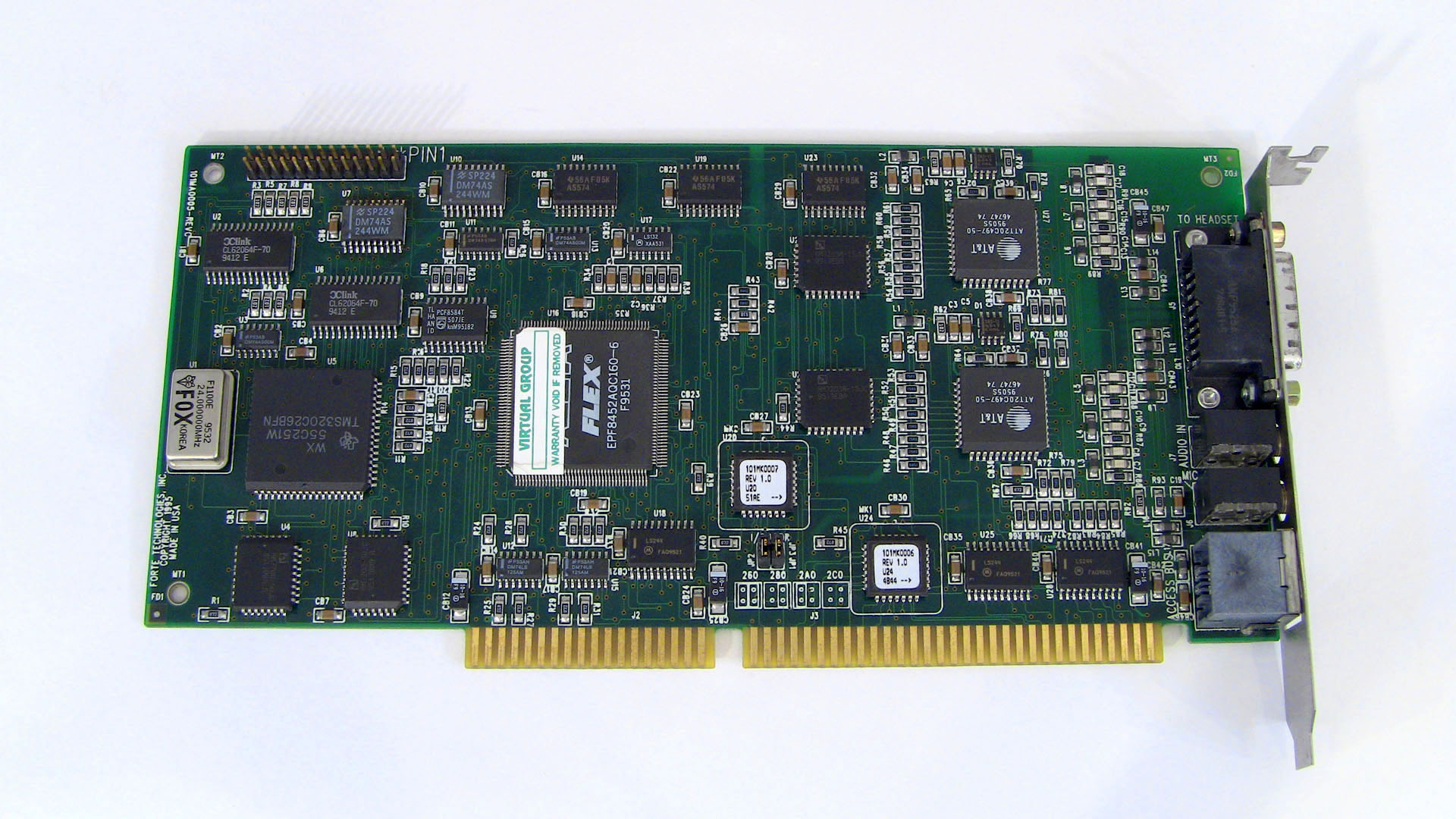VFX1 Headgear on:
[Wikipedia]
[Google]
[Amazon]
The Forte VFX1 was a consumer-level

 Visual: The helmet featured dual 0.7" 263 × 230 LCD displays capable of 256 colors. Optics comprised dual lenses with adjustable focus and interpupillary distance. Field of view was 45 degrees diagonally.
Auditory: The helmet included built-in stereo speakers and a condenser microphone. Audio signals were routed to the sound card's line in/out jacks.
Tracking: Head movements were tracked with internal sensors for pitch (70 degrees), roll (70 degrees), and yaw (360 degrees). A hand-held controller called the CyberPuck offered three buttons and internal sensors for pitch and roll. It could emulate a mouse and was connected to the helmet by an
Visual: The helmet featured dual 0.7" 263 × 230 LCD displays capable of 256 colors. Optics comprised dual lenses with adjustable focus and interpupillary distance. Field of view was 45 degrees diagonally.
Auditory: The helmet included built-in stereo speakers and a condenser microphone. Audio signals were routed to the sound card's line in/out jacks.
Tracking: Head movements were tracked with internal sensors for pitch (70 degrees), roll (70 degrees), and yaw (360 degrees). A hand-held controller called the CyberPuck offered three buttons and internal sensors for pitch and roll. It could emulate a mouse and was connected to the helmet by an  Interface: Audio, video, and tracking information was transmitted through the VIP Board, a 16-bit ISA card that received video input from the video card's 26-pin VESA feature connector and routed audio signals to the sound card's line in/out through external 1/8" audio jacks. Audio, video, and tracking data was exchanged with the headset over a single proprietary 8-foot cable, which could be daisy-chained for improved mobility.
Interface: Audio, video, and tracking information was transmitted through the VIP Board, a 16-bit ISA card that received video input from the video card's 26-pin VESA feature connector and routed audio signals to the sound card's line in/out through external 1/8" audio jacks. Audio, video, and tracking data was exchanged with the headset over a single proprietary 8-foot cable, which could be daisy-chained for improved mobility.
Virtual-Reality headset
* {{Mixed reality Products introduced in 1995 Virtual reality headsets
virtual reality headset
A virtual reality headset (or VR headset) is a head-mounted device that provides virtual reality for the wearer. VR headsets are widely used with VR video games but they are also used in other applications, including simulators and trainers. VR ...
marketed during the mid-1990s. It comprised a helmet, a handheld controller, and an ISA
Isa or ISA may refer to:
Places
* Isa, Amur Oblast, Russia
* Isa, Kagoshima, Japan
* Isa, Nigeria
* Isa District, Kagoshima, former district in Japan
* Isa Town, middle class town located in Bahrain
* Mount Isa, Queensland, Australia
* Mount ...
interface board, and offered head tracking, stereoscopic 3D, and stereo audio.
History
The VFX1 was developed in the early 1990s by Forte Technologies, Incorporated. It was released in 1995 with anMSRP
The list price, also known as the manufacturer's suggested retail price (MSRP), or the recommended retail price (RRP), or the suggested retail price (SRP) of a product is the price at which its manufacturer notionally recommends that a retailer ...
of US$695 and an average retail price of $599, and was sold in the US in retail stores including CompUSA and Babbage's. It was superseded by Interactive Imaging Systems' VFX3D in 2000.
Features

 Visual: The helmet featured dual 0.7" 263 × 230 LCD displays capable of 256 colors. Optics comprised dual lenses with adjustable focus and interpupillary distance. Field of view was 45 degrees diagonally.
Auditory: The helmet included built-in stereo speakers and a condenser microphone. Audio signals were routed to the sound card's line in/out jacks.
Tracking: Head movements were tracked with internal sensors for pitch (70 degrees), roll (70 degrees), and yaw (360 degrees). A hand-held controller called the CyberPuck offered three buttons and internal sensors for pitch and roll. It could emulate a mouse and was connected to the helmet by an
Visual: The helmet featured dual 0.7" 263 × 230 LCD displays capable of 256 colors. Optics comprised dual lenses with adjustable focus and interpupillary distance. Field of view was 45 degrees diagonally.
Auditory: The helmet included built-in stereo speakers and a condenser microphone. Audio signals were routed to the sound card's line in/out jacks.
Tracking: Head movements were tracked with internal sensors for pitch (70 degrees), roll (70 degrees), and yaw (360 degrees). A hand-held controller called the CyberPuck offered three buttons and internal sensors for pitch and roll. It could emulate a mouse and was connected to the helmet by an ACCESS.bus ACCESS.bus, or A.b for short, is a peripheral-interconnect computer bus developed by Philips and DEC in the early 1990s, based on Philips' I²C system. It is similar in purpose to USB, in that it allows low-speed devices to be added or removed fro ...
interface cable.
 Interface: Audio, video, and tracking information was transmitted through the VIP Board, a 16-bit ISA card that received video input from the video card's 26-pin VESA feature connector and routed audio signals to the sound card's line in/out through external 1/8" audio jacks. Audio, video, and tracking data was exchanged with the headset over a single proprietary 8-foot cable, which could be daisy-chained for improved mobility.
Interface: Audio, video, and tracking information was transmitted through the VIP Board, a 16-bit ISA card that received video input from the video card's 26-pin VESA feature connector and routed audio signals to the sound card's line in/out through external 1/8" audio jacks. Audio, video, and tracking data was exchanged with the headset over a single proprietary 8-foot cable, which could be daisy-chained for improved mobility.
System requirements
* IBM-Compatible PC with 386 CPU * VGA video card with 26-pin VESA feature connector * 16-bit ISA expansion slot for VIP board *MS-DOS 5.0
MS-DOS ( ; acronym for Microsoft Disk Operating System, also known as Microsoft DOS) is an operating system for x86-based personal computers mostly developed by Microsoft. Collectively, MS-DOS, its rebranding as IBM PC DOS, and a few oper ...
or later
* 500 KB free hard-drive space for drivers and utilities
* 20 KB conventional memory
In DOS memory management, conventional memory, also called base memory, is the first 640 kilobytes of the memory on IBM PC or compatible systems. It is the read-write memory directly addressable by the processor for use by the operating system ...
for drivers
* Optional: stereo sound card
References
External links
*Virtual-Reality headset
* {{Mixed reality Products introduced in 1995 Virtual reality headsets